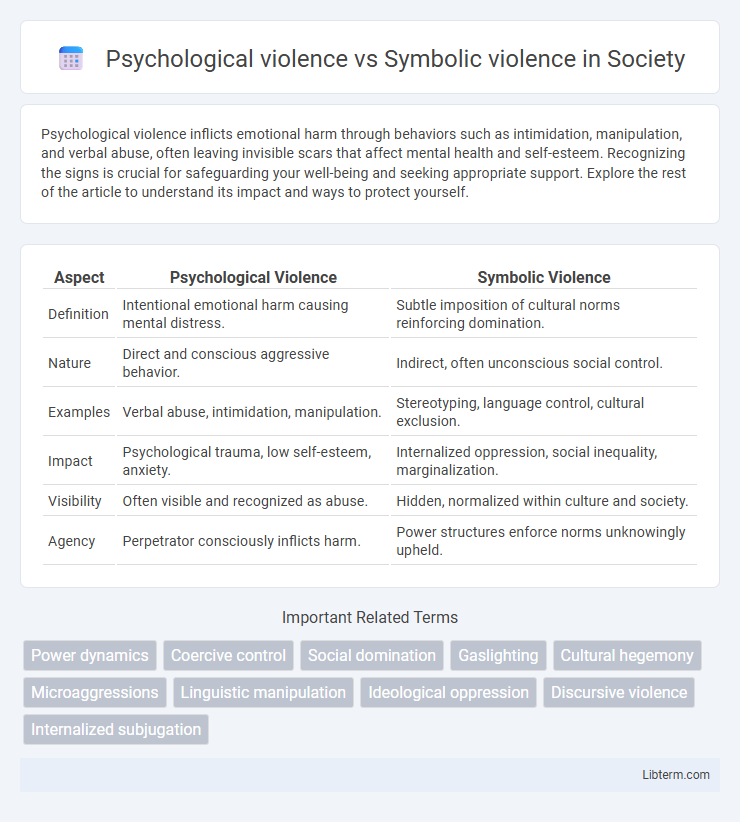Psychological violence inflicts emotional harm through behaviors such as intimidation, manipulation, and verbal abuse, often leaving invisible scars that affect mental health and self-esteem. Recognizing the signs is crucial for safeguarding your well-being and seeking appropriate support. Explore the rest of the article to understand its impact and ways to protect yourself.
Table of Comparison
| Aspect | Psychological Violence | Symbolic Violence |
|---|---|---|
| Definition | Intentional emotional harm causing mental distress. | Subtle imposition of cultural norms reinforcing domination. |
| Nature | Direct and conscious aggressive behavior. | Indirect, often unconscious social control. |
| Examples | Verbal abuse, intimidation, manipulation. | Stereotyping, language control, cultural exclusion. |
| Impact | Psychological trauma, low self-esteem, anxiety. | Internalized oppression, social inequality, marginalization. |
| Visibility | Often visible and recognized as abuse. | Hidden, normalized within culture and society. |
| Agency | Perpetrator consciously inflicts harm. | Power structures enforce norms unknowingly upheld. |
Understanding Psychological Violence: Definition and Scope
Psychological violence encompasses intentional acts that cause emotional harm, including verbal abuse, intimidation, and coercion, leading to long-term mental health issues like anxiety and depression. Symbolic violence, a concept developed by sociologist Pierre Bourdieu, refers to subtle, non-physical forms of domination embedded in cultural norms and language that reinforce power imbalances without overt aggression. Understanding psychological violence requires recognizing both explicit emotional abuse and the pervasive impact of symbolic violence within social structures.
What Constitutes Symbolic Violence? Key Concepts Explained
Symbolic violence refers to the subtle, often unnoticed imposition of dominant cultural norms and values that legitimize power imbalances, as defined by Pierre Bourdieu. It operates through language, gestures, and social practices that reinforce social hierarchies without physical force, distinguishing it from overt psychological violence, which directly targets an individual's mental well-being through intimidation or manipulation. Key concepts include misrecognition, where dominated groups internalize and accept their subordinate status as natural, perpetuating systemic inequality.
Historical Context: Origins of Psychological and Symbolic Violence
Psychological violence originates from early 20th-century studies on emotional abuse and trauma, highlighting individual mental harm through manipulation and intimidation. Symbolic violence, a concept developed by sociologist Pierre Bourdieu in the 1970s, refers to the systemic imposition of dominant cultural norms that reinforce social hierarchies and legitimize power imbalances. Both forms of violence reveal the nuanced ways power operates beyond physical harm, rooted in historical socio-cultural frameworks.
Manifestations of Psychological Violence in Everyday Life
Psychological violence manifests in everyday life through behaviors such as verbal abuse, manipulation, intimidation, and emotional neglect, undermining an individual's mental well-being and self-esteem. Unlike symbolic violence, which operates through cultural norms and social structures to impose dominance subtly, psychological violence targets personal boundaries and emotions directly, causing immediate harm. Common examples include gaslighting, constant criticism, and controlling actions that erode the victim's sense of autonomy and security.
Identifying Symbolic Violence in Social Structures
Symbolic violence operates through ingrained social norms and cultural practices that subtly perpetuate power imbalances and social hierarchies without direct physical or verbal aggression. It manifests in institutions like education, media, and language, where dominant groups impose their values and ideologies, leading to the internalization of inferiority among marginalized populations. Recognizing symbolic violence involves analyzing how social structures legitimize inequality by normalizing discrimination and maintaining systemic dominance.
Psychological Violence vs Symbolic Violence: Key Differences
Psychological violence involves direct harm through emotional abuse, manipulation, and intimidation aimed at destabilizing an individual's mental well-being. Symbolic violence, a concept introduced by sociologist Pierre Bourdieu, refers to subtle, often unnoticed power imbalances perpetuated through cultural norms, language, and social practices that reinforce dominance and social inequality. Key differences lie in their manifestation: psychological violence is overt and intentional, while symbolic violence operates covertly through everyday social interactions and accepted norms.
Impact of Psychological Violence on Mental Health
Psychological violence inflicts deep emotional and cognitive harm, leading to increased risks of anxiety, depression, and post-traumatic stress disorder (PTSD). Unlike symbolic violence, which operates through subtle social power dynamics and internalized oppression, psychological violence directly attacks an individual's self-esteem and sense of security. The cumulative impact impairs cognitive functioning and emotional regulation, contributing to long-term mental health disorders.
Symbolic Violence and Its Role in Cultural Dominance
Symbolic violence refers to the subtle, often unnoticed imposition of cultural norms and values by a dominant group onto marginalized populations, reinforcing social hierarchies through language, symbols, and institutions. This form of violence perpetuates cultural dominance by naturalizing inequality and shaping identities and beliefs in ways that sustain power imbalances without overt physical coercion. Psychological violence, while involving emotional harm through intimidation or manipulation, differs by being more direct and personal rather than embedded in systemic cultural structures.
Strategies for Addressing Psychological and Symbolic Violence
Effective strategies for addressing psychological and symbolic violence involve creating awareness through education that highlights the subtle and overt harms caused by these forms of violence. Implementing trauma-informed counseling and support services helps victims process their experiences and reclaim agency. Empowering marginalized groups through advocacy and policy reforms targets the systemic nature of symbolic violence, promoting inclusivity and social equity.
Building Awareness: Preventing Both Forms of Violence in Society
Psychological violence involves intentional harm to an individual's mental well-being through manipulation, intimidation, or emotional abuse, while symbolic violence refers to the subtle imposition of power and dominance through cultural norms and language that perpetuate inequality. Building awareness requires educational programs highlighting the harmful effects of both types, promoting empathy, and encouraging critical reflection on societal structures that enable symbolic violence. Preventive strategies include community workshops, media campaigns, and inclusive policies designed to challenge and dismantle these forms of violence at individual and systemic levels.
Psychological violence Infographic

 libterm.com
libterm.com